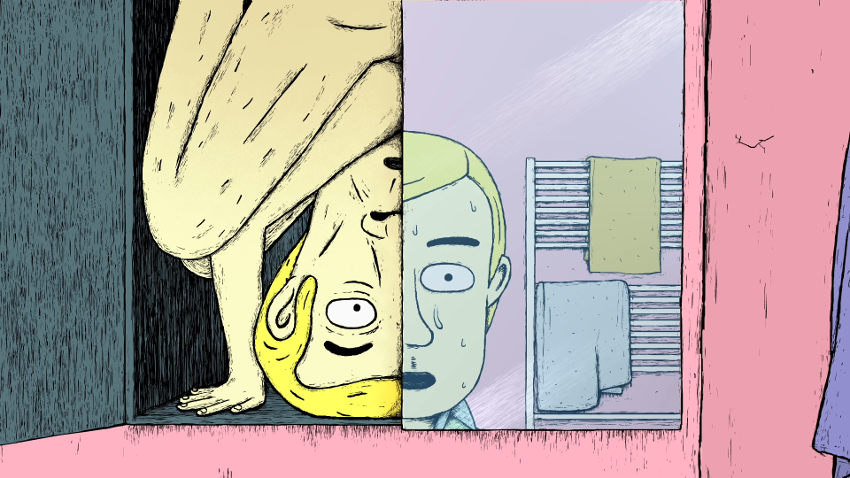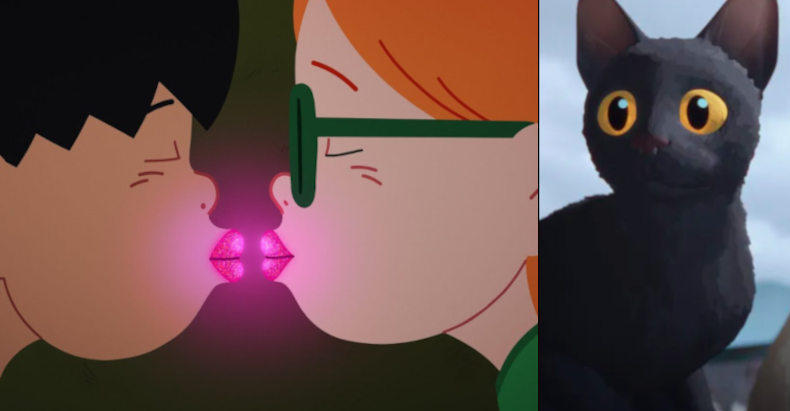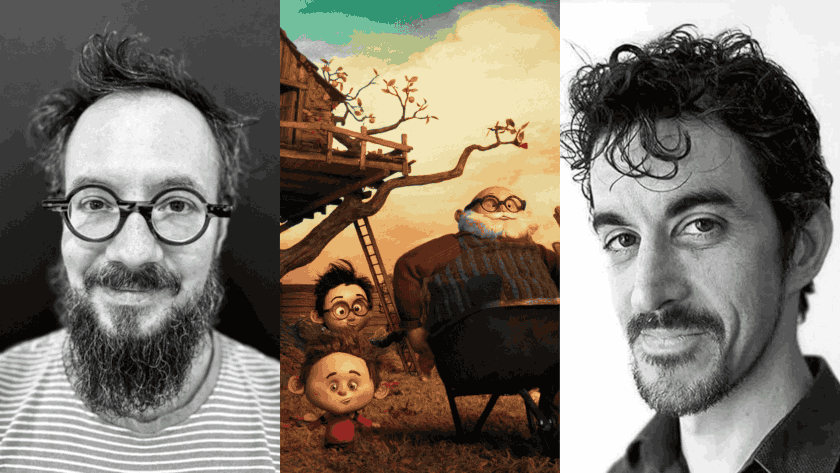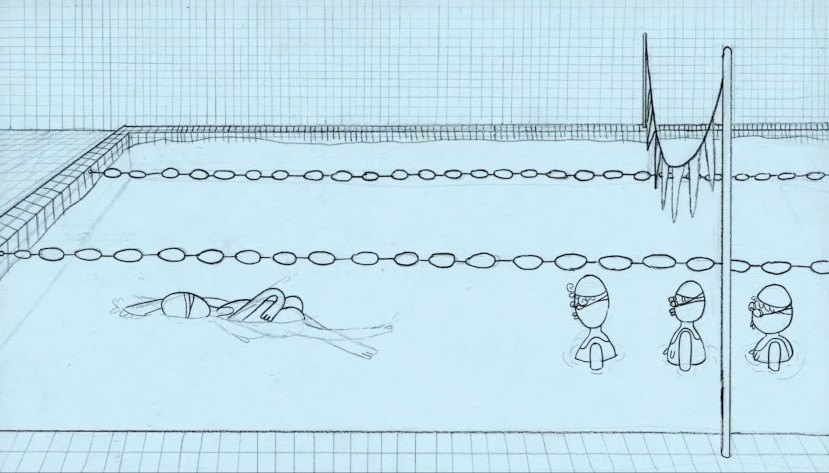I'm Going Out for Cigarettes (Je sors acheter des cigarettes) by Osman Cerfon

Osman Cerfon looks like one of those filmmakers that can pull off rabbits out of completely ordinary situations. in Sticky Ends pt.1, he's trying to convince us that a bear does not need to fly. In the second part, he actually involves rabbits.
In his latest film, I'm going out for cigarettes (Je sors acheter des cigarettes), 12-year-old Jonathan, lives with his sister, his mother and also some strange men who nest in closets, drawers, TV set. The film is produced by French company Miyu Productions, and premiered at Locarno Film Festival; a roller-coaster of festival awards followed (a list here).
Industry recognition came from both the French side (the film is shortlisted for a César award), and the US side of the Atlantic, where the film grabbed an Annie nomination for Best Short Subject. This is what makes Cerfon obviously glad (even though he was not expecting this climax, apart perhaps from the festival run); as he tells Zippy Frames, it made this a happier experience for this film in particular.
I had the feeling from the script stage that it had the potential to bring my work to some kind of personal achievement, show something more personal - Osman Cerfon
Watch I'm Going Out For Cigarettes:
Reflecting on the process of writing, Cerfon had both 'flashes of scenes' and consultation with Emmanuel Alain-Raynal (Miyu) to get the theme and the viewpoint of the film. What emerged from this advice was a treatment with the viewpoint of the boy character Jonathan.
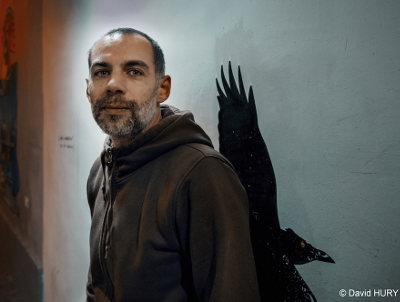 "At that time, that sounded not appealing to me at all" confesses Cerfon, "but I had nothing to lose trying. I wrote the treatment of the film in 5 hours, and basically everything was there". The final script version took longer, involving a lot of tiny adjustments and articulations; the animatic became another stage in the writing process itself, resulting in a film more personal that Cerfon initially aimed for.
"At that time, that sounded not appealing to me at all" confesses Cerfon, "but I had nothing to lose trying. I wrote the treatment of the film in 5 hours, and basically everything was there". The final script version took longer, involving a lot of tiny adjustments and articulations; the animatic became another stage in the writing process itself, resulting in a film more personal that Cerfon initially aimed for.
The film looks like a puzzle itself, in which later scenes have a reference to earlier ones as well, so there is always a deja-vu. "I wrote the film like an escape game in which you’d have to collect the clue to get out (cause it is all happening inside one flat", Cerfon elaborates "I also wanted that people who’ll watch it more than once to discover each time new things in the film. That’s why there are so many hidden details in it."
This is a definite advice to re-watch the film, for you can also get a glimpse of the supporting characters, Jonathan's bigger sister Louise, and their mother. "I didn’t want it to be just all about Jonathan" Cerfon mentions, "but I didn’t plan any quota, though". The female characters got progressively more space in the story, in order for the audience to care for their own issues and conflicts.
But, of course, the big issue in the film is the solid presence of people (and animals) almost indistinguishable from Jonathan, appearing behind every conceivable spot. Having monkey-like faces ("I wanted them to be really basic, between a pet and an imaginary friend"), their presence was always imagined to have a solid consistency in the filmic reality. "They can not cross walls. They are trapped in boxes (furniture, TV, washing machines).

The film's character’s all hide their secret relationship with this absent father in those "boxes".
Intimacy here becomes a tangible, but reflected representation, especially in the case of mum and the sister hiding in their room's drawers. The only time you’ll see the those 'ghosts' outside is when the boy is dreaming on the couch, during the "cleaning scene" - also, in the end scene before they disappear.
Reflection is central in I'm going out for cigarettes, and tells a lot about it's personality and it’s relationship to his own image.
There are three scenes in I’m going out for cigarettes in where a character faces a mirror. The first one is during the intro in the elevator, where the boy fools himself in front of two other kids, and it’s written "bastard" on him through the mirror reflection. In the second one, the mum is trying to lift her tired skin under her eyes. And the third, which is the most important to me, I show half of Jonathan’s face, shared with half of an imaginary dad’s one. This directly refers to a feeling I had when I was a teenager. As I grew up without knowing my father (not even his face), I remember watching myself in the mirror, wondering which part of my face comes from my mum and which one from my dad. This was like a puzzle I was unable to solve...
Even though the story has a personal resonance, he didn't go for a documentary route. There are no personal album photos or live-action footage of him in the film. "Since I hadn’t planned at the beginning to tell a personal story, I never considered it could be a documentary" he explains. "I always thought about it like a fictional narrative short (I have never seen strange people in closets in my life).This is where I feel more free to express myself.
That’s why I started studying animation, I really wanted to invent and tell stories.
Sometimes I am not even that keen on revealing that this story is partly related to my life. I don’t want this aspect to be pushed forward as a selling argument…"
Careful consideration had to follow with voice actors (not easy to find). Cerfon wanted both naturalistic voices and also 2 strong personalities for the young characters. Casting director, Sophie Diodovic, was an added convenience. "Once the choice has been made, you have to accept that a part of your character is re-defined by the actor’s proposition. This a bit risky, but also very exiting because it opens new perspectives".
His actors knew how to put themselves in this situation, and Cerfon didn’t explain them too much about the meaning of the scene. "It was more like 'think about how you’d react to that situation in real life'. Théan Van de Voorde (Jonathan), Manon Bresch (Louise), and Delphine Rollin (mother), had to stick to the lines for 75% of the script, and improvisation also followed. The boy actor had a pretty convincing attitude towards the girl that played his sister ("after 10 minutes I thought she’d punch him in the face").
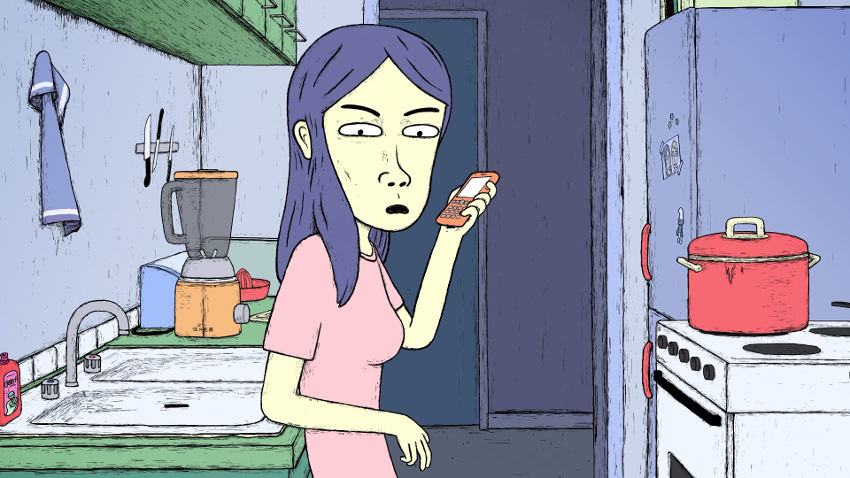
"During the recording session, I let the mum and the boy improvise during the night scene, when he wants to enter her room to get his cards back", Cerfon explains. " I recorded them together for the exchange between them to sound more real and spontaneous. Her instructions were not to let him in, no matter what. I think we did five takes, and the boy was so annoyingly insistent, that every-time she gave up and she let him get in. I had to choose the best one and cut it before the end. That’s why she seems so rude to him, closing the door to his face in the film"
Vibrant yellows, pinks and purples permeate the film, and create a palpable contrast. On the other hand, the backgrounds are so detailed you actually want to enter the house. The topography of I'm going out for cigarettes is a thing that can't be missed. Cerfon built the flat (even before creating the storyboard) on 3D software, paying a lot of attention to details ("I placed the kitchen's sink in the exact same position as the bathroom’s tube, like it would be practical in a real flat… When I think about it, this is really stupid").
Each room in the film has its own story to tell; the living-room, the kitchen, the bathroom, the sister's room (with a huge UK flag, an idea due both to background artist Darshan Fernando, as well as Cerfon's own experiences). Cerfon also pays special attention to the boy's room, the one you never see in the film. Yet, if he had to choose his favorite space, it would be the bathroom ("I like light and the colors we found for this room").
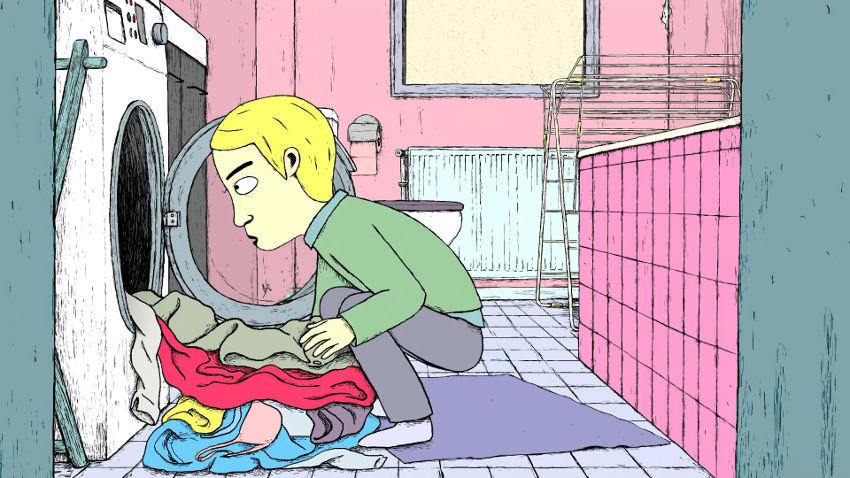
Sergei Prokofiev's Romeo and Juliet plays a huge part in giving away a confrontation in absence, as well as the Stabat Mater Dolorosa. Cerfon had already these two titles as reference from the script stage; the decision to use them was solidified at the animatic stage ("If I had known in advance how much Universal would charge for 45sec of music, I would probably have decided to work with a composer").
Cerfon now tries to fund a TV series project he created with Benoit Audé (Miyu productions still on board): it is a family story called voodoo meow. He remains a smoker, and he definitely goes out for cigarettes, but he promised Zippy Frames to quit if he gets a César or an Annie award.
Film Review (Vassilis Kroustallis)
Imagine Beavis and Butthead moving to a place in France, and then having to look into the cupboards for missing Texas cowboy ancestors with heavy metal sympathies. Osman Cerfon's I'm Going Out For Cigarettes perfectly captures the art of pretending not giving a f*ck -but still care about everything. Every element in this flexible storywise, yet tightly constructed film points to an act where you have to re-discover your self and roots (in cupboards, laundry machines, TV, cleaning services). The meticulously portrayed apartment (each room has its own identity) makes external shots unnecessary: everything you need to find is in these four walls. It is evident that the absence of the father and its trauma is the resonant topic of the film, and it haunts even the main character's playing cards. But the film gives room both to the sister and the mum to present their own world, and in the end, it becomes a tale of survival: you need to take the garbage out, even if it was not you who actually had a lunch and a dinner. Α film that hits all the right notes without even you feeling that it tries to do so.
About Osman Cerfon
Osman Cerfon is a French animated film director born in 1981. After studying graphic design and training at the Beaux-Arts in Epinal, Osman Cerfon completed his studies at La Poudrière school. He directed three films, including Tête-à-tête, his graduation film. After school, he collaborated on various projects as a screenwriter or technician for Folimage, then at Je suis bien content, studio that produced the two parts of Chroniques de la Poisse, two short films selected and awarded in many festivals (including Annecy, Hiroshima). At the birth of his first child, he accepts the direction of several order films to pay the diapers and the nanny ...
I’m going out for cigarettes is his first short film produced by Miyu Productions, an animation studio with which he develops in parallel Voodoo Meow an original series project of 52 episodes.
CREDITS:
I'm Going Out for Cigarettes (Je sors acheter des cigarettes) by Osmar Cerfon (France 2018, 13' 35'')
2D Computer animation
Produced by Emmanuel-Alain Reynal and Pierre Baussaron - Miyu Productions
Animation / Animation : Capucine Latrasse, Remi Schaepman, Quentin Marcault, Valentin Stoll
Compositing : Mathieu Brisebras
Cast: Théan Van de Voorde (Jonathan), Manon Bresch (Louise), Delphine Rollin (La Mère), Valentin Gevraise (L’Ado)
Layout: Lucrèce Andreae | Editing: Albane du Plessix, Catherine Madenise | Sound editing: Pierre Sauze | Soundtrack advisor: Adelie Prod – Nathanaël Bergese
Distribution: Miyu Distribution (Luce Grosjean)



